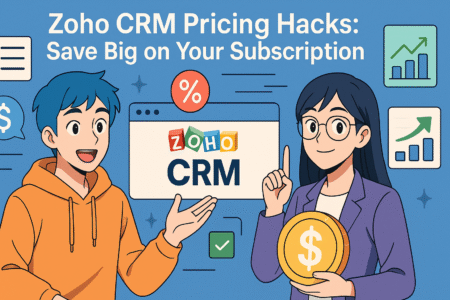Are you wondering how to start an online digital marketing business in 2025? This guide breaks down essential steps, tools, and strategies to help you launch and scale your digital marketing venture successfully.
From understanding the market to crafting a winning strategy, we’ll answer all your questions and provide actionable insights for success.
Identifying Lucrative Niches For Your Business
Finding the right niche is one of the most critical steps when learning how to start an online digital marketing business. A well-chosen niche helps you focus your efforts, attract the right clients, and position yourself as an expert. Let’s explore how to uncover niches that align with your skills and market demand.
Analyzing Market Demand For Digital Marketing Services
Understanding market demand ensures you’re targeting industries and clients that genuinely need your services. This step is all about research and awareness.
First, start by exploring trending industries. Technology, health, and e-commerce have shown consistent growth, making them excellent areas to consider. Use tools like Google Trends or industry-specific reports to assess which sectors have growing demand for digital marketing.
Second, evaluate what competitors are doing. Look at successful digital marketers or agencies in your desired niches. Analyze their websites, services, and client reviews to understand where they excel and what opportunities you might tap into.
Third, consider local versus global demand. If you’re targeting small businesses, focusing locally might be more effective. On the other hand, industries like SaaS or e-commerce benefit from a global approach.
Lastly, pay attention to pain points. I believe this is key—industries struggling with poor online visibility, low engagement, or outdated marketing strategies are ripe for your expertise. Offering solutions to these challenges can help you secure loyal clients.
Narrowing Down Target Audiences And Industries
A focused target audience increases your chances of connecting with the right clients. This is about identifying specific groups of businesses or individuals who will benefit most from your digital marketing expertise.
Think about who you want to work with. For instance, if you’re passionate about fitness, targeting gym owners, wellness coaches, or health product brands can feel more rewarding and relatable.
Evaluate client budgets and needs. I suggest prioritizing industries or businesses with consistent marketing budgets. A startup may have potential, but a mid-sized company or established brand may offer more reliable income.
Leverage demographics and psychographics. Understanding factors like age, income, interests, and values helps tailor your messaging. For example, a younger audience might respond better to social media-heavy campaigns, while older demographics may value email marketing.
Experiment with micro-niches. Instead of targeting “health,” focus on “organic skincare brands” or “personal trainers for seniors.” Micro-niches reduce competition and allow you to become a trusted expert in a smaller segment.
Choosing Profitable Niches With Growth Potential
Selecting a niche isn’t just about passion; it’s also about profitability. A profitable niche ensures your efforts yield financial rewards, which is essential when starting your digital marketing business.
Research trends in high-growth sectors. Industries like AI, fintech, and green energy are rapidly expanding and demand innovative digital marketing solutions. Staying ahead in these spaces gives you a competitive edge.
Look for repeatable needs. I recommend niches with ongoing marketing requirements, such as e-commerce stores needing consistent social media campaigns or service businesses requiring SEO optimization.
Assess competition wisely. Too much competition in a niche might make it harder to stand out, but no competition could indicate a lack of demand. Strike a balance by choosing a niche with moderate competition and room for innovation.
Validate your niche choice. Before committing, test your chosen niche by reaching out to potential clients or running small campaigns. If there’s positive feedback or interest, it’s a good sign you’re on the right track.
By focusing on a well-researched and carefully chosen niche, you’re setting a strong foundation for your digital marketing business to thrive. Remember, the key is to align your skills with market needs, ensuring mutual value for you and your clients.
Crafting A Clear Business Plan For Success

A clear business plan is essential when learning how to start an online digital marketing business. It sets the foundation for your goals, finances, and growth strategies, guiding your decisions and keeping your efforts focused. Let’s break down the key components of a successful business plan.
Defining Goals And Objectives For Your Business
Setting goals provides direction and purpose for your business. Without clear objectives, it’s easy to lose focus and momentum.
Start with what you want to achieve. I suggest thinking about both short-term and long-term goals. For example, your short-term goal could be landing your first three clients within three months, while your long-term goal might be scaling to a six-figure income within two years.
Make your goals measurable. Rather than aiming to “grow the business,” focus on specific metrics like increasing website traffic by 50% or generating $5,000 in monthly recurring revenue. Measurable goals let you track progress effectively.
Keep your goals realistic yet challenging. Aim for objectives that push you to grow without becoming overwhelming. If you’re just starting, setting goals to dominate the digital marketing space in six months isn’t practical, but building a strong reputation within a niche is achievable.
Focus on aligning your goals with your niche and market demand. For instance, if you specialize in social media management, a goal might include launching a portfolio of case studies showcasing your results within six months.
Estimating Start-Up Costs And Budget Allocation
Understanding your costs ensures you manage resources wisely while launching your online digital marketing business. It’s about balancing investment and profitability.
Start with basic expenses. These include registering your business, purchasing tools (like SEO software or design platforms), and building a website. I recommend using a spreadsheet to outline every cost, so nothing gets overlooked.
Separate one-time costs from ongoing expenses. For example, designing your logo might be a one-time cost, but subscribing to tools like Canva or AIOSEO is ongoing. Knowing this distinction helps you budget more accurately.
Prioritize investments that generate results. While it’s tempting to splurge on a fancy office setup, I suggest focusing on essentials like marketing tools, education, or initial paid ads to attract clients. These directly impact your growth.
Prepare for unexpected costs. It’s wise to set aside an emergency fund. Things like unexpected tool upgrades or additional freelance support can arise, and having a buffer ensures you’re not caught off guard.
Outlining Key Revenue Streams For Digital Marketing
Diverse revenue streams make your business resilient and profitable. A well-rounded income strategy ensures steady growth and helps weather market fluctuations.
Start with services that match your expertise. If you excel in content creation, offer blog writing or video marketing services. Your initial offerings should align with your strengths to deliver top-notch results and build client trust.
Expand into value-added services. Once you’ve established trust, upselling or cross-selling becomes easier. For instance, a client might start with SEO but later request social media management or paid advertising services.
Explore passive income opportunities. I believe creating digital products like eBooks, courses, or templates can supplement your income. These not only add value to clients but also position you as an authority in your niche.
Build recurring revenue through retainers. Instead of one-time projects, aim for ongoing client relationships. Monthly retainer agreements for services like SEO or content marketing provide consistent income and long-term stability.
Crafting a strong business plan ensures you’re prepared for the challenges and opportunities ahead. With clear goals, a realistic budget, and diversified revenue streams, you’re setting your digital marketing business up for success.
Setting Up Your Online Presence Professionally
Setting up a professional online presence is a crucial step when figuring out how to start an online digital marketing business. A polished and functional digital foundation establishes credibility and helps attract your target audience effectively.
Registering A Domain Name That Resonates With Your Brand
Your domain name is the first impression of your online business. Choosing one that aligns with your brand and niche can make a huge difference in building trust and recognition.
Start with simplicity. A short and memorable domain name is easier to type and recall. I suggest avoiding hyphens or numbers, as they can confuse potential visitors. For example, “TopMarketingExperts.com” is more effective than “Top-Marketing123.com.”
Include your niche or keywords. Using relevant terms in your domain name can improve SEO and immediately tell users what you offer. For example, if you specialize in social media marketing, a domain like “SocialGrowthHub.com” adds clarity and relevance.
Check availability on social media platforms. I recommend securing matching handles for your business across major platforms like Instagram, Twitter, and LinkedIn. Consistency across channels strengthens your brand identity.
Secure the right extensions. While “.com” is the gold standard, don’t shy away from alternatives like “.net” or “.co” if your preferred choice is taken. For regional businesses, local extensions like “.uk” or “.ca” can also work well.
Designing A Conversion-Optimized Business Website
A well-designed website is your business’s digital storefront. It should not only look professional but also guide visitors toward becoming clients.
Focus on user experience. I suggest using a clean layout with intuitive navigation to keep visitors engaged. Make sure the site loads quickly and is mobile-friendly, as most users browse on their phones.
Highlight key services and calls to action. Your homepage should clearly showcase your expertise and invite visitors to take the next step, whether that’s contacting you or signing up for a consultation. Use buttons like “Get Started Now” to encourage conversions.
Include testimonials and portfolio samples. Building trust is essential when starting an online digital marketing business. I believe displaying reviews or examples of your work can reassure potential clients of your skills.
Use professional visuals. Invest in high-quality images or graphics to elevate your site’s appearance. If you’re not confident in your design abilities, hiring a freelance designer can be a worthwhile investment.
Optimizing Your Website For Search Engines
SEO is a vital part of making your website visible to your target audience. Effective optimization helps your site rank higher in search results, driving organic traffic to your business.
Start with keyword research. I recommend identifying terms your audience is searching for, such as “digital marketing for small businesses.” Incorporate these naturally into your website copy, headings, and meta descriptions.
Optimize technical elements. Ensure your site has fast loading times, secure HTTPS protocols, and a mobile-friendly design. Search engines prioritize these factors, so addressing them boosts your rankings.
Create valuable content. Blogging about topics related to your niche is a great way to attract visitors. For example, if your business focuses on email marketing, writing a guide like “5 Email Campaign Tips to Boost Engagement” can showcase your expertise.
Add internal and external links. Linking to other pages on your site improves navigation and keeps visitors exploring your content. I also suggest including credible external links to support your claims and improve your site’s authority.
Setting up your online presence professionally ensures that your business is ready to attract and convert clients. From a standout domain name to a fully optimized website, every step you take strengthens your foundation for long-term success.
Choosing The Right Tools And Technologies

Selecting the right tools and technologies is essential when figuring out how to start an online digital marketing business. The tools you choose can determine how effectively you deliver results, save time, and manage your business operations.
Selecting Software For SEO, Analytics, And CRM
SEO, analytics, and CRM software form the backbone of any successful digital marketing business. They help you monitor performance, optimize strategies, and maintain client relationships.
Begin with SEO tools like Ahrefs, SEMrush, or Moz. These platforms provide insights into keywords, backlinks, and competitor performance. I recommend using these tools to identify high-value keywords, optimize on-page content, and track rankings to ensure your strategies align with client goals.
Analytics tools like Google Analytics and Hotjar are invaluable for understanding user behavior. Google Analytics helps you track website traffic and user engagement, while Hotjar reveals heatmaps and user flow patterns, showing where your audience interacts most. This combination gives you a full view of your marketing effectiveness.
For CRM (Customer Relationship Management), consider platforms like HubSpot, Zoho CRM, or Salesforce. These tools streamline client interactions, making it easier to manage leads, track sales, and nurture relationships. I believe investing in a CRM early helps you stay organized as your client base grows.
Test different tools to see what works best. Many offer free trials, which I suggest taking advantage of to evaluate features and ensure compatibility with your workflows.
Leveraging Automation Tools To Streamline Operations
Automation is a game-changer for efficiency. It frees up time and ensures consistency in your digital marketing efforts.
Email marketing platforms like Aweber or ActiveCampaign allow you to automate email sequences. For example, you can set up a welcome series for new subscribers or reminders for upcoming promotions. This keeps your campaigns running smoothly without manual effort.
Social media scheduling tools like Buffer and Hootsuite simplify content management. With these, you can plan, create, and schedule posts across multiple platforms in advance. I recommend leveraging analytics from these tools to refine posting times and engagement strategies.
Workflow automation tools like Zapier or Integromat connect your apps and streamline repetitive tasks. For instance, you can automatically add new leads from a web form into your CRM or trigger an email alert for a new client inquiry.
Keep track of automation results. While automation saves time, I advise periodically reviewing workflows to ensure they’re effective and aligned with your goals.
Building A Toolkit For Content Creation And Distribution
Creating and sharing high-quality content is essential in digital marketing. Your content toolkit should enable you to produce engaging materials efficiently.
Start with graphic design tools like Canva or Adobe Creative Cloud. Canva is user-friendly and ideal for creating social media posts, infographics, and presentations. For more advanced needs, Adobe tools like Photoshop or Illustrator provide professional-level design capabilities.
Video marketing tools like Adobe Premiere Pro or platforms like Canva Video are perfect for creating polished videos. Whether it’s tutorials, testimonials, or promotional content, video remains a top-performing medium in digital marketing.
Content writing tools like Grammarly and Hemingway ensure your copy is clear and error-free. I suggest using AI-powered tools like Jasper or ChatGPT to generate content ideas or refine drafts, but always review to maintain your voice.
Content distribution platforms like Buffer or Missinglettr help you share your work effectively. These tools let you schedule and repurpose content across various channels, maximizing reach and engagement.
Choosing the right tools and technologies empowers you to deliver exceptional results for your clients. As you build your digital marketing business, your investment in reliable tools will directly impact your efficiency, scalability, and success.
Building A Strong Portfolio And Credibility
A strong portfolio is essential when learning how to start an online digital marketing business. It demonstrates your skills, builds trust, and helps you attract clients who align with your expertise.
Creating Sample Campaigns To Showcase Your Expertise
If you’re just starting, creating sample campaigns is one of the best ways to demonstrate your capabilities and build confidence in potential clients.
Start with mock campaigns. I suggest picking a niche you’re passionate about and designing a hypothetical marketing strategy. For example, create a social media content plan for a small bakery or an email drip campaign for an e-commerce brand. Show how you would drive engagement or conversions with creative visuals and actionable steps.
Leverage tools for professional presentations. Canva, Google Slides, or even Adobe Spark can help you present these campaigns in a polished way. Use clear metrics or goals, like projected click-through rates or hypothetical ROI, to showcase your analytical approach.
Collaborate with local businesses. If you need real-world examples, offer to run free or discounted campaigns for startups or small businesses in your area. In return, you’ll gain tangible results to showcase in your portfolio.
Keep your portfolio updated. As your experience grows, replace older samples with more recent and impactful work. Highlight your most successful campaigns first, as these are likely to capture client attention quickly.
Collecting Testimonials And Case Studies For Trust
Testimonials and case studies are powerful tools for building credibility. They provide social proof and demonstrate the real-world impact of your digital marketing efforts.
Ask for feedback proactively. Once you complete a project, request a testimonial from your client. I recommend guiding them with specific questions, like what challenges you helped them overcome or the results they experienced. This ensures their response is detailed and meaningful.
Document your success. Case studies go deeper than testimonials by outlining the challenges, solutions, and results of a specific project. For example, describe how you helped a local florist increase online orders through targeted Facebook ads, including metrics like “30% revenue growth in three months.”
Use visuals to enhance your case studies. Include screenshots of campaign analytics, before-and-after metrics, or charts to make your results more tangible. These details help potential clients visualize your capabilities.
Display them prominently. I suggest dedicating a section of your website to testimonials and case studies. Position them where visitors can easily see them, such as your homepage or portfolio page.
Highlighting Niche-Specific Success Stories
Showcasing your expertise within a specific niche helps you stand out and attract clients looking for specialized digital marketing services.
Focus on your best-performing niches. If you’ve had success with real estate clients, for example, highlight campaigns that demonstrate your ability to generate leads through Google Ads or Instagram Stories. Tailor the narrative to showcase your deep understanding of the industry’s challenges.
Create content around your niche. Write blog posts or LinkedIn articles about strategies relevant to your target industry. For instance, if you’re targeting e-commerce brands, share insights like “5 Proven SEO Tactics to Increase Online Store Traffic.” This positions you as an authority and brings organic traffic to your site.
Network within your niche. Attend industry events, join forums, or participate in webinars related to your chosen field. I believe building connections in your niche increases visibility and can lead to valuable referrals or collaborations.
Highlight unique value. Emphasize what makes you the right choice for that niche. For instance, if you specialize in helping eco-friendly brands, mention how you integrate sustainable messaging into digital campaigns to align with their values.
Building a strong portfolio and showcasing your credibility takes time, but it’s an investment that pays off. With sample campaigns, glowing testimonials, and niche-specific success stories, you’ll build trust and attract clients eager to work with your business.
Launching A Strategic Marketing Plan

A strategic marketing plan is the backbone of how to start an online digital marketing business successfully. With a clear roadmap, you can attract the right clients, maximize conversions, and establish your brand as a trusted expert.
Developing A Content Marketing Strategy For Leads
Content marketing is a proven way to attract and nurture leads. By creating valuable and relevant content, you can position your business as a go-to resource for your audience.
Start with audience research. I recommend identifying the questions, challenges, and interests of your target clients. Tools like PeopleAlsoAsk or surveys can help uncover what they’re searching for online. Use this information to craft blog posts, guides, or videos that address their needs.
Focus on evergreen content. Articles or resources that remain relevant over time, such as “How to Improve Your Google Ads ROI,” continue to generate traffic and leads long after they’re published. I believe this kind of content is worth the initial effort.
Promote your content strategically. Share it across platforms where your audience is most active. For instance, if you’re targeting small business owners, LinkedIn might be a great channel, while younger audiences might prefer Instagram or TikTok.
Encourage lead generation with gated content. Create resources like eBooks, checklists, or templates and offer them in exchange for an email address. This way, you’re not just sharing information but also building a list of potential clients to nurture further.
Crafting Social Media Campaigns That Convert
Social media is an essential channel for any digital marketing business. It’s where you can showcase your expertise, engage with potential clients, and drive conversions.
Choose platforms based on your audience. If you’re targeting B2B clients, LinkedIn might be your primary focus, while visually-driven platforms like Instagram or Pinterest work well for lifestyle brands. I suggest starting with two platforms to avoid spreading your efforts too thin.
Create engaging content formats. Short videos, carousel posts, and polls often get more engagement than static images or long posts. Use these formats to demonstrate your expertise, share case studies, or ask questions that spark conversation.
Leverage hashtags and trends. Research trending hashtags in your niche to improve content discoverability. For example, if you’re posting about SEO tips, hashtags like #SEOTricks or #DigitalMarketing can help your post reach a wider audience.
Analyze and optimize. Use platform analytics to track which posts perform best. I advise experimenting with different posting times, formats, and topics, then refining your strategy based on the results.
Running Paid Ads To Drive Quick Results
Paid advertising is a powerful way to generate quick results for your online digital marketing business. With the right approach, you can attract high-quality leads while keeping costs under control.
Start with a clear goal. Determine whether you’re aiming to drive traffic, generate leads, or increase brand awareness. For instance, a lead generation campaign might use Facebook Lead Ads, while Google Ads are better for driving traffic to your website.
Target the right audience. Platforms like Facebook and Google Ads allow precise targeting based on demographics, interests, and behaviors. If your niche is e-commerce, focus on users interested in online shopping or specific product categories.
Test different ad creatives. I suggest creating multiple versions of your ads with variations in images, headlines, and copy. This lets you see what resonates most with your audience and optimizes your ad performance.
Track ROI carefully. Use analytics tools to monitor the performance of your campaigns. Keep an eye on metrics like cost per click (CPC), conversion rates, and return on ad spend (ROAS). This helps you refine your approach and maximize results.
Launching a strategic marketing plan ensures your business not only gains visibility but also connects with the right audience. With well-executed content strategies, engaging social media campaigns, and effective paid ads, you’ll be equipped to attract leads and scale your digital marketing business successfully.
Networking And Building Partnerships
Building strong networks and partnerships is vital when learning how to start an online digital marketing business. These connections help you expand your reach, gain insights, and grow your client base faster.
Collaborating With Influencers To Amplify Reach
Partnering with influencers is an effective way to increase visibility and credibility for your digital marketing business. Influencers already have an engaged audience, making them ideal collaborators.
Begin with niche-specific influencers. I suggest identifying influencers whose followers align with your target audience. For instance, if you focus on e-commerce marketing, connect with influencers who frequently work with online stores or product-based businesses.
Build genuine relationships. Instead of approaching influencers with a cold pitch, engage with their content first. Comment on their posts, share their work, and show genuine interest. This makes your eventual collaboration pitch more personal and likely to succeed.
Offer mutual value. Think about what you can provide to the influencer, such as creating content for them, sharing your expertise, or helping them with their own marketing. Collaborations that benefit both parties are more successful and long-lasting.
Measure collaboration success. Track metrics like increased website traffic, lead inquiries, or social media engagement to evaluate the results of your partnership. I recommend refining your approach based on these insights for future collaborations.
Joining Digital Marketing Communities For Insights
Digital marketing communities are treasure troves of knowledge, trends, and opportunities. Being part of these groups can help you stay informed and connect with potential clients or partners.
Explore popular platforms. Communities exist on LinkedIn, Facebook, Reddit, and Slack. For example, groups like “Digital Marketing Professionals” on LinkedIn or “BigSEO” on Reddit offer valuable discussions and networking opportunities.
Participate actively. I believe the key to benefiting from these communities is engagement. Share your insights, ask thoughtful questions, and contribute to ongoing discussions. Active participation helps establish you as a knowledgeable professional.
Use communities to learn. Pay attention to common challenges or questions members raise. This can guide your content creation or service offerings, ensuring you address real-world problems your audience faces.
Network strategically. Look for collaboration opportunities with other members, such as co-hosting webinars, guest blogging, or exchanging services. These partnerships can help expand your reach and build your reputation.
Partnering With Complementary Businesses
Partnering with businesses that offer services complementing yours can open new opportunities and boost client referrals. These partnerships create win-win scenarios for both sides.
Identify complementary services. If your expertise is in SEO, consider partnering with web developers, content writers, or graphic designers. Their clients might also need SEO, and vice versa, creating a natural referral pipeline.
Build trust with partners. I suggest starting with small projects or trials to ensure compatibility. Open communication and delivering excellent results will strengthen the partnership and encourage long-term collaboration.
Create joint offerings. Offer bundled services that combine your expertise with your partner’s. For example, a combined package of website design and SEO optimization could attract clients looking for a one-stop solution.
Promote each other. Feature your partners on your website, social media, or email campaigns, and ask them to do the same. This cross-promotion increases visibility for both businesses and reinforces credibility in front of potential clients.
Networking and partnerships are not just about expanding your reach; they’re about creating meaningful connections that support long-term growth. With influencers, communities, and complementary businesses on your side, your digital marketing business can achieve significant momentum.
Mastering Client Acquisition And Retention

Mastering client acquisition and retention is crucial when figuring out how to start an online digital marketing business. Attracting the right clients and keeping them satisfied ensures steady growth and long-term success.
Building A Strong Lead Generation Funnel
A well-designed lead generation funnel guides potential clients through every stage of their decision-making process, making it easier to turn prospects into paying customers.
Start with top-of-funnel strategies. I recommend using blog posts, social media content, and webinars to capture attention. These resources should provide valuable insights related to your services, such as “5 SEO Tips to Improve Local Rankings.” The goal is to spark interest and position yourself as a knowledgeable resource.
Optimize lead magnets. Offer something valuable, like an eBook, checklist, or free consultation, in exchange for a prospect’s email address. For instance, a downloadable guide on “Creating a Winning Social Media Strategy” not only attracts leads but also showcases your expertise.
Use landing pages effectively. Your landing page should have a clear message, a strong call-to-action (CTA), and minimal distractions. Include testimonials or data-driven results to build trust and encourage visitors to take the next step.
Automate follow-ups. Tools like Convertkit or Mailmunch help nurture leads with personalized email sequences. These emails should address common challenges, highlight your services, and invite prospects to book a call or demo.
Converting Prospects Into Long-Term Clients
Turning prospects into loyal clients requires a mix of trust-building, clear communication, and delivering value from the outset.
Focus on the initial interaction. The first consultation or meeting is critical. I suggest asking thoughtful questions about their goals, challenges, and expectations. Showing genuine interest helps establish a connection and builds trust.
Tailor proposals to client needs. Generic proposals can turn off prospects. Instead, customize your pitch to demonstrate how your services address their specific challenges. Include details like expected results, timelines, and deliverables to make your offer more compelling.
Be transparent about pricing and expectations. Clients appreciate honesty, so provide a clear breakdown of costs and what they can expect from your services. This avoids misunderstandings and sets a positive tone for the relationship.
Show results early. If possible, deliver a quick win during the onboarding process. For example, optimizing their website’s meta descriptions or setting up an initial ad campaign can demonstrate your skills and build confidence in your abilities.
Implementing Retention Strategies For Consistent Growth
Retaining clients is just as important as acquiring them. Long-term relationships provide stability and reduce the effort spent on constant client acquisition.
Deliver exceptional results. This might seem obvious, but consistently meeting or exceeding client expectations is the foundation of retention. I suggest setting clear goals and keeping clients updated on progress with regular reports.
Communicate regularly. Keep the lines of communication open with weekly or monthly check-ins. Ask for feedback, discuss new opportunities, and address any concerns promptly to maintain trust and satisfaction.
Offer additional value. Beyond your core services, consider providing educational resources or sharing industry insights tailored to their needs. For instance, sending a quarterly newsletter with actionable tips can reinforce your value and keep clients engaged.
Build loyalty programs. Reward long-term clients with discounts, exclusive access to new services, or complimentary strategy sessions. These gestures show appreciation and encourage clients to continue working with you.
Mastering client acquisition and retention ensures a steady stream of business and helps your digital marketing business thrive. With a strong lead generation funnel, a focus on client satisfaction, and retention strategies that foster loyalty, you’ll create a sustainable and successful business model.
Staying Ahead With Industry Trends And Updates
Staying current with industry trends is essential when learning how to start an online digital marketing business. The digital landscape evolves quickly, and adapting to these changes helps you remain competitive and deliver top-notch results.
Adapting To Search Engine Algorithm Changes
Search engine algorithms are constantly changing, which impacts how digital marketing strategies perform. Staying informed and agile ensures your business thrives in a competitive environment.
Start with reliable sources. I recommend following trusted SEO platforms like Moz, Search Engine Journal, and Google’s official updates. These resources provide timely insights into algorithm changes and what they mean for your strategies.
Audit your website regularly. Algorithm updates often prioritize factors like mobile-friendliness, page speed, and user experience. Conduct frequent audits to ensure your website aligns with the latest standards. Tools like Google PageSpeed Insights or Screaming Frog are helpful here.
Embrace E-A-T principles. Google values Expertise, Authority, and Trustworthiness in content. Focus on creating high-quality, accurate, and relevant materials. For example, if your niche is healthcare marketing, ensure your content is supported by credible sources and showcases your expertise.
Test and adapt strategies. When algorithms shift, your existing tactics may need adjustments. I suggest experimenting with new approaches, such as focusing on long-tail keywords or enhancing on-page SEO, to maintain or improve rankings.
Exploring Emerging Digital Marketing Channels
New digital marketing channels constantly appear, offering fresh opportunities to connect with your target audience. Exploring these channels can give your business an edge and expand your reach.
Monitor trends on platforms like TikTok, Clubhouse, or Threads. These channels are gaining popularity among younger demographics. For example, I’ve noticed many brands successfully use TikTok for storytelling and product promotions, making it worth exploring.
Diversify your efforts. Relying on just one or two channels can limit your growth. Experiment with a mix of platforms, such as YouTube for video content, Pinterest for visual campaigns, or podcasts for in-depth discussions.
Evaluate ROI on new channels. Not all emerging platforms will work for your niche. I suggest starting small, tracking performance metrics like engagement or conversions, and scaling efforts on channels that show strong results.
Stay authentic. Whether you’re creating a short-form video or hosting a webinar, focus on genuine, engaging content. Audiences are drawn to brands that share real stories and value their time.
Investing In Continuous Skill Development
Digital marketing is a field that requires constant learning. Staying ahead means sharpening your skills and staying informed about new tools, strategies, and best practices.
Enroll in courses and certifications. Platforms like Udemy, Skillshare, or Coursera offer certifications in areas like SEO, PPC, and analytics. I recommend setting aside time each quarter to complete a course that aligns with your goals.
Attend webinars and conferences. These events provide valuable insights into current trends and offer networking opportunities. Look for industry-specific events like Social Media Marketing World or MozCon to deepen your expertise.
Experiment with new tools. I believe testing tools like AI-driven analytics platforms or content creation software can help you work more efficiently. Stay open to innovations that enhance your services.
Build a personal learning routine. Dedicate time each week to read industry blogs, watch tutorials, or experiment with new strategies. This habit keeps you informed and ready to tackle the latest challenges in digital marketing.
Staying ahead with industry trends and updates ensures your digital marketing business remains competitive and relevant. By adapting to algorithm changes, exploring emerging channels, and investing in your skills, you position yourself as a leader in a dynamic industry.
Scaling Your Business To New Heights
Scaling your business is the natural next step when you’ve established a strong foundation in how to start an online digital marketing business. Growth requires expanding resources, diversifying services, and planning strategically for the future.
Expanding Your Team For Greater Efficiency
Building a capable team is essential for scaling your business. A strong team allows you to handle more clients, deliver better results, and focus on high-level strategy.
Start with clear hiring goals. I recommend identifying areas where you need the most support, such as content creation, social media management, or client communication. Bringing in experts for these roles frees you up to focus on scaling strategies.
Hire freelancers or contractors. If you’re not ready for full-time employees, working with freelancers is a cost-effective way to expand your team. Platforms like Upwork or Fiverr are excellent places to find skilled professionals who can handle specific tasks.
Develop a streamlined onboarding process. I believe having a clear onboarding system helps new team members quickly understand their roles and align with your business values. This might include training materials, tools, and clear instructions for workflows.
Focus on collaboration. Regular team meetings, project management tools like Trello or Asana, and open communication channels help ensure everyone stays on the same page. A cohesive team drives efficiency and improves client satisfaction.
Diversifying Services To Meet Client Demands
As your business grows, diversifying your services ensures you meet the evolving needs of your clients. It also helps you stay competitive and increase revenue streams.
Identify gaps in your current offerings. Look at your clients’ most common requests. For example, if you’re providing SEO services, clients might also need help with paid advertising or content marketing. Expanding into these areas can deepen client relationships.
Introduce new services gradually. I suggest starting with one or two additional services and testing their effectiveness. For instance, you could add social media ad management or email marketing to your offerings before expanding further.
Bundle services for added value. Creating package deals that combine complementary services can attract more clients. For example, a “Digital Growth Package” including SEO, social media management, and analytics reporting provides a comprehensive solution for businesses.
Invest in the right tools and training. Offering new services often requires learning new skills or adopting advanced tools. Ensure your team is equipped and trained to deliver high-quality results in these new areas.
Setting Long-Term Goals For Sustained Success
Establishing long-term goals is essential for ensuring your business thrives well into the future. Clear objectives guide your decisions and keep you focused on meaningful growth.
Define your vision for the future. I recommend asking yourself where you want your business to be in 5 or 10 years. Whether it’s becoming a leader in a specific niche or expanding into international markets, having a vision keeps you motivated.
Break goals into achievable steps. For example, if your goal is to triple revenue within three years, outline the strategies you’ll use to get there, such as acquiring more clients, increasing service rates, or launching new services.
Stay adaptable. The digital marketing industry evolves rapidly, so it’s crucial to revisit your goals regularly. I suggest reviewing them every six months to ensure they still align with industry trends and your overall vision.
Celebrate milestones. Acknowledging your achievements, whether it’s landing a major client or surpassing revenue targets, keeps you and your team motivated. Celebrations also reinforce a positive work culture.
Scaling your business to new heights requires careful planning, a dedicated team, and the ability to adapt to your clients’ needs. With a focus on efficiency, diversification, and long-term goals, your online digital marketing business will be well-positioned for sustained success.






